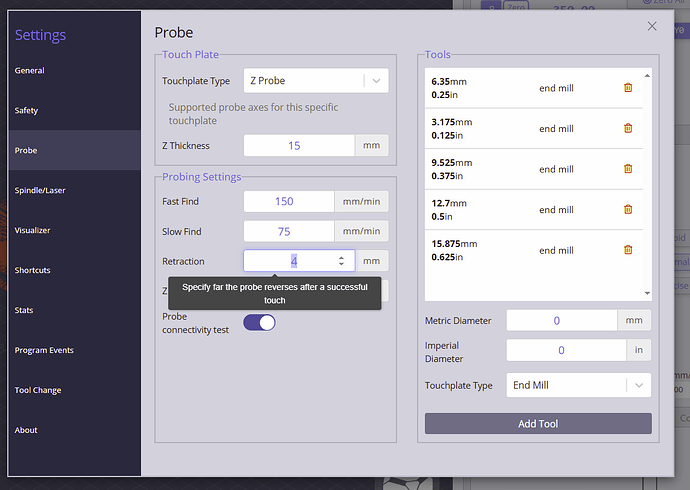This is not really a problem, more of a request. I am using the auto touch plate in combination with gSender and all appears to be working fine. After I zero the Z-axis, the tool retracts to a new position. The issue is that I would like it to retract higher so that I have room to install my dust collector “shoe”. Is there a place where I can change the setting as to how high it retracts?
Hello! @Jimc137, I agree! I have the same difficulty as what you reported. My current work around is I document the Z height after using my auto touch plate, raise it, install my dust shoe and lower it to the original height. While not perfect, it makes installing my dust shoe easier. Hope this helps!
Jake
Hey Jake,
I beleive once it is zeroed, it doesn’t matter if you return it to it’s origional heigt. The zero-heigt remains the same unless you bang it into max height.
But, out of fear of losing my zero, I too bump the z up with a known amount (mostly 25mm) en drop it that same amount. mostly when moving xy direction to probe flatness around my stock using calibrate and a touch plate.
Needed it is not, but doing things consistantly helps minimize triggering and ensures recovering - after the sure to be made oopsy.
I wonder if the retraction setting is something usable if you use z-probe with the z-thickness set to the thickness of the required touch plate.
Something to play around with once I get out of my laser jobs.
I think that makes sense, we’d need to figure something out though: how high of a movement would you want to have happen? Since of the movement is quite a bit then it could be a risk where if you Z-prove taller material your Z-axis runs out of space to move
In a perfect world, it would be a variable in the settings. Currently, I raise it about 1/2” above the current value, so maybe 3/4 to 1”?
That is the distance it retracts between fast and slow probes.
I ended up writing a macro for the z probe and raise enough to install dust probe.
I understand the that after using the auto zero touch plate, the bit moves to xy0 and 1mm above Z Zero.
Is there a way to adjust that 1mm to something larger? Say 19mm (3/4") or something similar?
I was wondering this as well. I always have to manually raise the Z to put the dust show on.
gSender does have a safe height feature but I’m not sure if it affects probing or not. If you decide to try the safe height in gSender be aware that it’s behavior depends on whether you have limit switches/sensors or not.
If you don’t have switches the safe height is a distance up from zero but if you do have switches the number is a distance down from the top of the Z. At least that’s how it used to work and I remember they added a section about it in the docs but I can’t seem to find it anymore.
I don’t use the safe height in gSender so I’m not sure if it’s behavior has changed or not. I’d be careful, keep the stop button handy, until you figure out it’s behavior. Another thing is it has no effect on your gcode like a safe height in Vectric, Fusion etc. It’s only used for some gSender functions when not running gcode.
The Safe Height only affects movement. That is, the spindle moves to the safe height when you use the Go to XY0, or go to the corners. It’s an AltMill, so it does have limit switches.
I have my safe height set to 1.5".
I’ll jump in here, cause I am still at 1.2.2 and know I trail behind, but this final retract seperate from probing retract would come in handy when I have a hold down running accros my work piece. I implement such a hold down technique when I need to mill on the edges.
This introduces the need for a retract hight after probing to not run into the contraption when going xyzero (the clamp strip runs middle project). I end up setting a 35mm retract watching the probing routine creaping down for ages and some.
I use the same manner when I probe machine bed with a high project. It works, but I think the #3 request is to help the reduce probing time in these situations.
I however am not requesting this, I get it though.
Having the cutter raised above the height of the touchplate after probing would make removing the touchplate a bit easier.
It would also be nice to have the touchplate cables made of a more supple cable such as the cables used with the inductive sensors.
